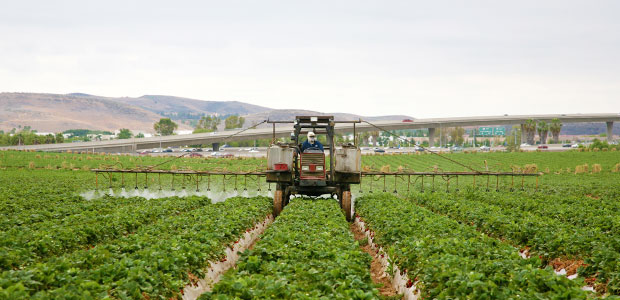
California Bans Chlorpyrifos After Concerns for Children’s Health
The new ban will affect many farmers and agriculture workers in the state, as they will no longer be allowed to use the widely used insecticide based on its threat to human health.
After extensive research by the California Environmental Protection Agency, the state of California is ending the use of chlorpyrifos—a pesticide associated with neurodevelopmental problems and impaired brain function in children.
One U.S. News article breaks down the conversation: what the pesticide is, why it’s harmful, why it took so long to reach this conclusion, what’s special about California and how the U.S. EPA is involved.
What is Chlorpyrifos and How is it Used?
The article describes chlorpyrifos as an inexpensive and effective pesticide that has been on the market for decades—since 1965. Farmers across the country use millions of pounds of it to grow crops including many vegetables, corn, soybeans, cotton and fruit and nut trees.
It is an organophosphate insecticide, which means it is designed to kill insects by blocking an enzyme called acetylcholinesterase. This enzyme has another function, however: it normally breaks down acetylcholine, a chemical that the human body uses to transmit nerve impulses. Organophosphate insecticides are effective for killing insects, but they are also toxic and potentially lethal to humans.
Chlorpyrifos was used in homes for pest control until 2000, after a 1996 Food Quality Protection Act banned its indoor use and required additional protection of children’s health. However, residues left after indoor use were very high, and toddlers who crawled on the floor and put their hands in their mouth were at risk of poisoning.
Still, the pesticide lingers in households and human bodies. Over 75 percent of people in the U.S. still have traces of chlorpyrifos in their bodies, mostly due to residues on food. For farm workers or those working near agricultural fields, their exposures are often higher.
How do We Know Chlorpyrifos is Harmful?
The first study to link chlorpyrifos to potential development harm in children was published in 2003. The study found that higher levels of chlorpyrifos metabolite—a substance that’s produced when the body breaks down the pesticide—in umbilical cord blood were significantly associated with smaller infant birth weight and length.
Other studies in 2006 and 2014 supported the idea that the insecticide affects child and fetus development, and many of those same infants with developmental delays persisted into childhood, with lower test scores on standard tests of development and changes that researchers could see on MRI brain scans. They were also more likely to have neurodevelopmental delays.
These findings started a movement by many researchers to protect children from chlorpyrifos. However, some scientists were skeptical of the epidemiological studies: they argued these studies can prove something is harmful, but results can be muddled by gaps in information about timing and level of exposures. Results can also be complicated by other factors such as diet, personal habits, homes and workplaces.
Still, researchers were beginning to agree: the insecticide was harmful, in some capacity, to humans—infants, agriculture workers and others.
What Took So Long?
Basically, it was a difference in testing, and perspective, between the U.S. EPA and California that made the evaluation of the pesticide so drawn-out.
At first, both groups focused on the established toxicity mechanism: acetylcholinesterase inhibition. They reasoned that preventing significant disruption of this key enzyme would protect people from other neurological effects.
In 2014, some scientists published a complex model under contract for Dow Chemical uses methods from the 1970s and 1980s that is now considered unethical. California scientists questioned the Dow-funded model and wondered with the acetylcholinesterase inhibition was really the most sensitive biological effect.
In 2016, the U.S. EPA released a reassessment of chlorpyrifos’s potential health effects with a different approach. It focused on epidemiological studies published from 2003 through 2014 at Columbia University that found developmental impacts in children exposed to chlorpyrifos based on mothers’ cord blood at birth. The EPA attempted to back-calculate how much chlorpyrifos they might have been exposed to throughout pregnancy.
On the basis of this analysis, the Obama administration called for a ban of chlorpyrifos and said the substance could not be safely used. However, the Trump administration reversed this decision in 2017, arguing that more study was needed. California, as a state, was very much conflicted on what to do.
What Convinced California of the Ban?
Three independent studies, published in 2017 and 2018, used chlorpyrifos on rats to evaluate subtle effects on learning and development. The results were consistent: chlorpyrifos caused decreased learning, hyperactivity and anxiety in rat pups. The results were eerily similar to effects seen in human epidemiological studies, vindicating health concerns about the pesticide.
Ultimately, California reassessed the pesticide and concluded that it could not be mitigated—especially among people who lived near agricultural fields where it was used. In October 2019, the state announced that all sales of chlorpyrifos to California growers would end by Feb. 6, 2020, and growers would not be allowed to possess or use it after December 31, 2020.
California is not alone, though. Hawaii has already banned chlorpyrifos, and New York state is phasing it out. Other states are also considering action.
What’s the U.S. EPA’s View?
In July 2019, the EPA asserted that “claims regarding neurodevelopmental toxicity must be denied because they are not supported by valid, complete, and reliable evidence.” It said it would continue to review the evidence and hopefully reach a decision by 2021.
There’s no question this is a public health concern in some regards. Now, it’s a matter of how many more studies are needed—if any more at all—to protect children, workers and citizens.
For more information on the subject, various studies on the pesticide and regulations, read the
U.S. News article.